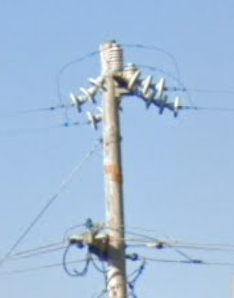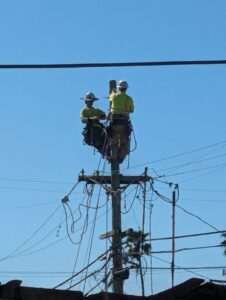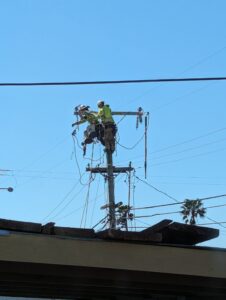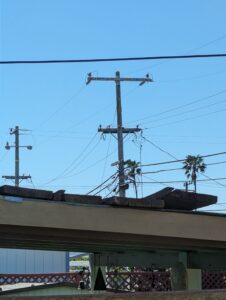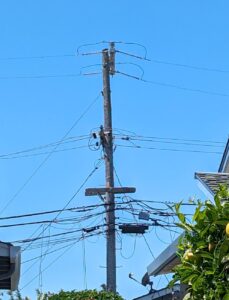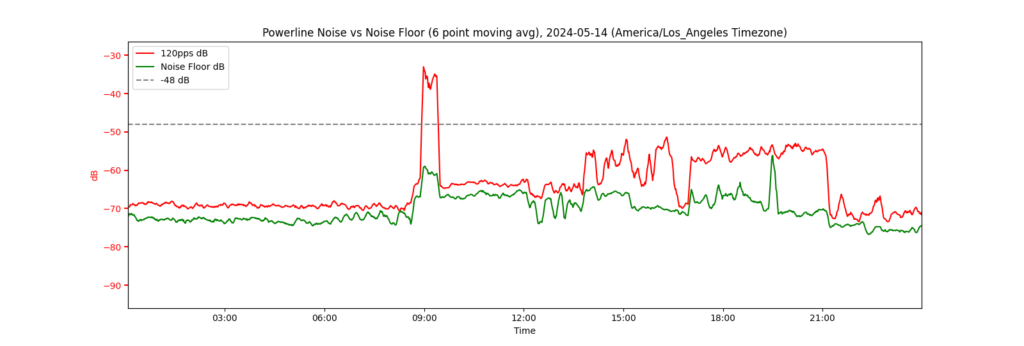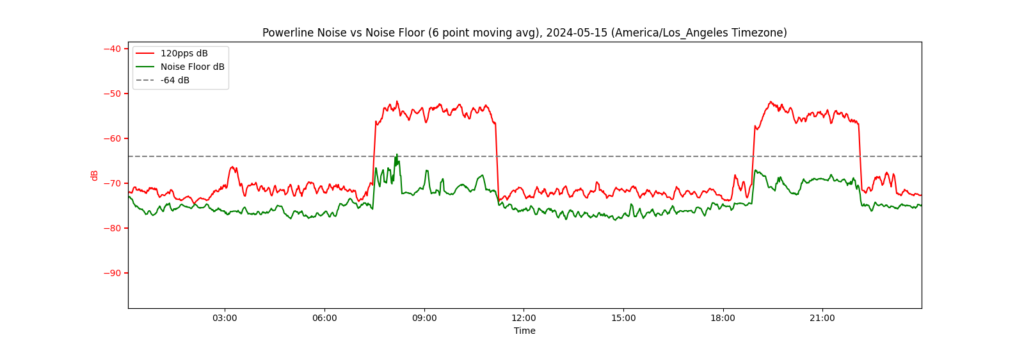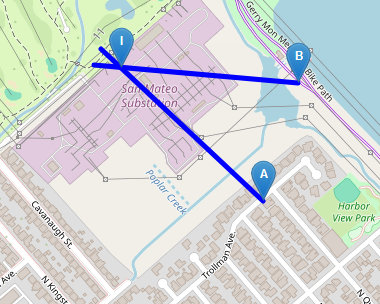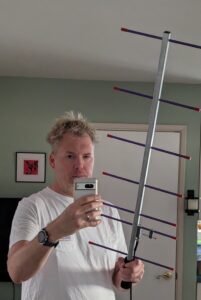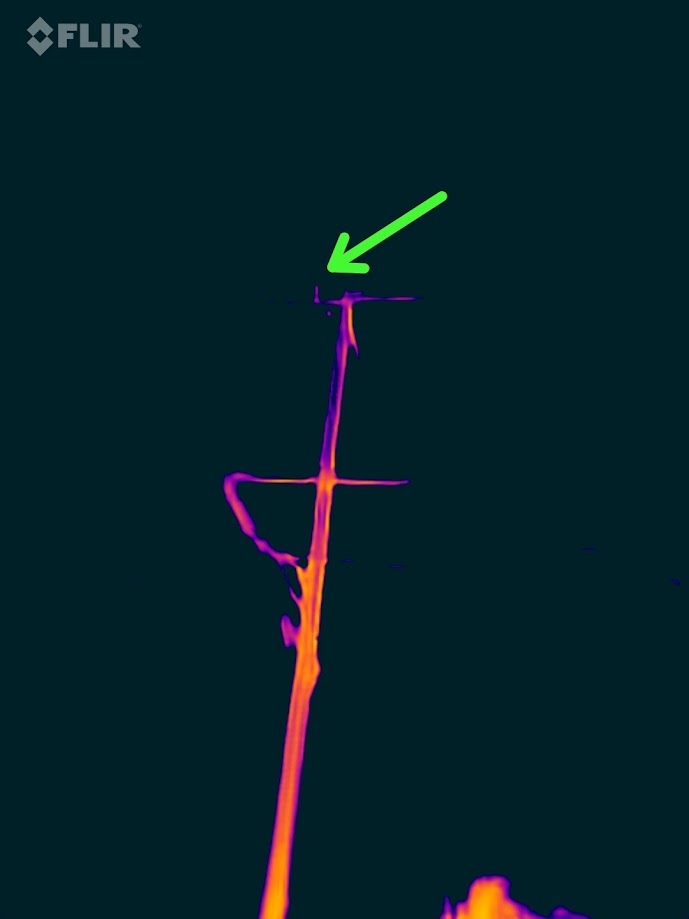The Existing System
The system I started out with has a “B Grade” solar panel that a local company sells at a discounted price, feeding into a relatively inexpensive PWM solar controller, which charges a pair of AGM 35-amp-hour wheelchair batteries and controls the load, which is the PowerPole distribution panel on my desk.
The Problem
Several months ago, when West Mountain Radio started selling a new and improved version of the excellent N8XJK “Super Booster” I decided to finally get one. This handy device steps up the voltage presented to the radio to that of your choosing. Doing so is of value with many radios during transmit, because they operate more efficiently closer to 15 volts than they do at lower voltages.
Of course you don’t get something for nothing in this world, and increasing the voltage to the rig means the Booster needs to draw more current. When I’d initially set up my solar system, I used a relatively inexpensive 20 Amp PWM solar controller and all AWG #12 wiring. This was fine when my intentions were simple and modest; however, with the Super Booster in operation, and my wanting to transmit with more than 30 watts or so, problems soon became apparent. The voltage drop leading into the Booster during transmit was considerable during transmit, and the current quickly grew to the full capacity of the cheap controller.
Recalling my college physics and EE courses, I knew that the voltage drop was likely due to resistance in the wiring when drawing that much current, and that the only way to fix this would be to run heavier wire. And if I was going to run heavier wire, I might as well make other upgrades too, so that I could pull a full 30 Amps and transmit with 100 watts output.
Options, options, options!
I knew that if I was going to spend the money upgrading, I should look into going to an MPPT controller, but MPPT controllers are notorious for creating broadband hash noise on HF, so I knew a cheap Chinese controller was not going to be an option. On the opposite end of the spectrum, you can easily spend $600-800 on a top-of-the-line controller that doesn’t do much but charge a battery elegantly, and that felt a little steep to me. I wanted something that would be a good value.
After doing a great deal of researching, and some discussion with their support via email, I decided on a BlueSky Energy controller. Other hams had also reported on forums that their controllers are RF-quiet. BlueSky’s support, even for someone who hasn’t bought anything yet, is quite simply amazing. They are based in Vista, California and are part of SunForge LLC. When you ask a question, you get a good answer from a real human being, not a canned response from someone who reacted to two keywords in your email.
BlueSky’s philosophy seems to be one of modularity. They have a handful of core controller products aimed at different use cases, but rather than being all-in-one monolithic products, they’re just the first part of the solution. You can then add on other products specific to your needs.
The Components
I opted for the SB2512iX-HV solar controller. The “X” in the model number indicates that the controller features load control, which can be used either charge an auxiliary battery or operate a low-voltage-disconnect load relay (with optional “on at dusk” capability if you wanted to do landscape lighting, or only turn a load on after dark).
The only problem with the 2512 is that the load control is only rated for 25 amps, which is a bit less than the 30+ I wanted to draw. Fortunately, there’s a component for that. BlueSky sells a Current Booster Module, the CBM4070, which is essentially a hefty MOSFET. Rather than running your load directly off the 2512, you instead use the load control on the 2512 to open the gate on the MOSFET, and then you connect your battery to the source and your load to the drain. The CBM is rated up to 70 amps for continuous DC (or 40 amps for PWM applications, which don’t apply here).
To keep an eye on how everything is behaving and to configure the system, BlueSky sells the IPN ProRemote. Support offered to let me borrow one for the sake of programming; however, I knew I would want to always have access to tinker and to monitor, so I purchased one.
A fun aside here: from this project and the IPN ProRemote I learned how current shunts work for measuring DC current. It’s all rather clever: the shunt is an extremely low, but not zero, passive resistance device that can handle a lot of current. By measuring the voltage in parallel with the shunt, and knowing what the resistance of the shunt itself is, you can use Ohm’s Law to calculate the current flowing across the device. If, for example, the resistance is 0.1 ohms, and you measure 0.1 volts across the shunt, then the current crossing the shunt is 1 amp (I = E/R). It’s not remarkable- just something I hadn’t learned about previously.
The IPN ProRemote connects to the solar controller via an ordinary RJ11 telephone cable, and to the shunt using customer-supplied twisted pair wire. I used twisted pair AWG 22 bell wire. Cheap ethernet cable would work just as well. Presumably they want to use twisted pair to avoid common mode noise being misinterpreted as voltage across the shunt. A kind of nice feature of the ProRemote is that it fits in an ordinary dual-gang electrical box, so you can mount it directly into a wall.
Setup
I keep my batteries outdoors in marine battery boxes to protect them from the elements, and I decided that for the sake of simplicity I would also move the charge controller and the current booster outdoors to a weather-resistant (NEMA 3R) steel electrical box. This is probably not something you’d want to do if you live in a very warm climate, because the current booster and the charge controller both generate some heat. If I had it to do again, I think I might even use a bigger box than I did; I selected a 12″x12″ (30×30 cm) box for this purpose, and 14×16 would have allowed a little more breathing room and working room inside. Still, my system is on the north side of our house which is in the shade most of the day, and I’m hoping the metal box will act to some extent as a heat sink for the components inside. It isn’t perfectly sealed- air can and does get in and out.
The other reason I wanted a metal box for the charge controller is that this also has the effect of putting the controller inside a Faraday cage. I’ve read reports from a number of hams that BlueSky’s controllers are already nearly RF-silent, and the manual indicates that they are in fact Part 15 B compliant. They also ship with a pair of ferrite cores to attach to the PV input and to the IPN cable. But there’s almost nothing quite like a Faraday cage (box) to contain a signal.
Still, if I start having heat-related problems this summer, then this decision might require some rethinking. In the worst case, I’ll have to run an extra cable out to the batteries and move the controller indoors. The controller is good up to 45 degrees Celsius / 113 degrees Fahrenheit. It’s pretty rare for us to see outdoor temperatures above 80 F here in Northern California, though what counts is the temperature inside the box. I’ll be keeping an eye on it, and the controller will shut itself down if its internal temperature gets too high.
To make things easy to change in the future, I used PowerPole connectors on everything, and I used keychain labels zip-tied to each cable to keep track of what each cable is; it can and does get a little confusing when you have many cables that all look the same inside a steel box.
Wiring everything is straightforward. As I mentioned above, the Current Boost Module is connected to the auxiliary CHG connection on the 2512. Though this is current limited to 2A, I wired it with the same #10 I was using for everything else. The battery grounds are connected to one side of the shunt, and all the other grounds are connected to the other side of the shunt. I also ran a ground wire from the box itself to the load side of the shunt and to the station’s outdoor ground bus, just to ensure everything related to the station remains at the same ground potential.(Edit: this turns out to be the wrong thing to do; it creates a second path to the battery ground, bypassing the negative-side fuses from fuse pairs, and also causing any negative-side sensing current meters to produce incorrect values because not all of the current passes through them. I’ve since removed the connection to the outside ground bus, but kept the connection to the box.) The load is fed from a separate connection to the battery positive, through the load side of the CBM. I could have run this with just a single positive wire, but I opted to run a second pair, again with the battery negative on the battery side of the shunt, and the positive to the CBM. After double- and triple-checking everything, it was time to test the system.
Power Up
Following instructions, I connected the battery power to the 2512 first, then connected the PV power. Then, using my multimeter, I checked the output of the Current Boost Module, and found a very happy 14 volts. Then I connected the “shack” power and went indoors.
I turned on my radio, and it started to power up… then immediately shut off. What? What could be happening? After some troubleshooting, and revisiting the manual, I found the problem: DIP switch 3 ships in the “off” position (which is totally reasonable, mind you) indicating that the CHG output of the 2512 is going to be used to charge an auxiliary battery. In this configuration, it is mandatory that the auxiliary battery’s negative be connected to the main battery negative.
But that isn’t my configuration: I’m using the CHG connector as a low-voltage disconnect to run my ham gear. I believe what was happening was the 2512 was correctly sensing that current was flowing to something which was not directly connected to the battery’s negative terminal, or turning the rig on temporarily dropped the voltage just enough to drop the system out of Absorption or Float mode, in which case the AUX charge is disabled.
Whatever the case may be, it was solved by shutting the system down, flipping DIP switch 3 to the ON position, and powering back up. This puts the system into Low Voltage Disconnect mode.
I turned on my radio, and it stayed on!
Monitoring and Programming
The next thing to do was to set up the IPN ProRemote. BlueSky has cleverly sized this device to fit perfectly into a two-gang outlet box. I decided to use a low-voltage (open back) ring rather than a standard old work box just because I find them so much easier to work with when higher voltages are not required. Installation was straightforward- the RJ11 connector goes into the remote, the twisted pair shunt connection goes into the shunt screw connectors, and that’s it.
As I anticipated, when the sun is down (and it was by the time I got this far), the ProRemote will show a negative charge current on the display. If you trace out what’s happening in the shunt circuit, this makes perfect sense. What you’re observing is the current going TO the battery, from the perspective of the system. So if the sun is down, and all the charge is coming FROM the battery, that’s a negative value. You can also think of the display value as the charge current, minus the load current.
It’s clear some thought has gone into the design and embedded software of the ProRemote. Navigation is straightforward and achieved with a minimal number of buttons, but it isn’t particularly easy. That’s okay, though, because the menus are well-organized and you should only need to step through the deeper setup menus once in a great while.
Factory defaults are almost what you need to get started. The manual recommends changing the Acceptance Charge Time to 4 hours, setting the correct number of amp-hours for your batteries, and setting the self-discharge rate based on your battery specifications. In my case this meant setting 70-amp hours and a self-discharge rate of 3% per 30 days for my AGM batteries (two 35 AH connected in parallel).
I have to say the thing looks really sharp mounted flush with the wall behind my desk.
The Verdict
So far, so good! The hams who have previously reported that BlueSky MPPT controllers are RF-quiet are not wrong. Even inside a metal box, you could expect some RFI to leak on the wiring leading from the controller, but the supplied ferrite clamped to the PV wiring and the IPN cabling seems to do the trick. I don’t detect any noise on my radio, at least not above our suburban noise floor.
It’s impressive how little sunlight is required for the 2512 to begin charging. At only about half an hour past sunrise, when my panel was still well in the shade, the battery is already charging modestly.
But by far the most satisfying thing is being able to turn the transmit power on my radio all the way up to 100 watts, watch the current increase to about 25 amps, and see only a very minimal voltage drop on the supply side. The physics of the solution to the problem worked out exactly as they should have. I made two quick contacts with Japan with little effort, and called it a day.
If you’re a ham running on renewable energy and looking to switch to MPPT controllers, don’t throw good money after bad on the cheapest no-name Chinese controller you can find on Amazon. It’s worth spending a little more to get a good value and something that you’re not going to hear on HF. I found Blue Sky Energy’s hardware to be a good value, especially for use with ham radio.
